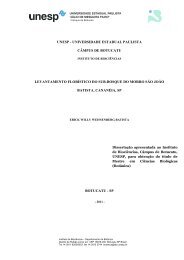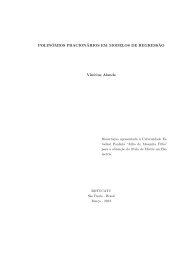Visualizar Tese - Instituto de Biociências - Unesp
Visualizar Tese - Instituto de Biociências - Unesp
Visualizar Tese - Instituto de Biociências - Unesp
Create successful ePaper yourself
Turn your PDF publications into a flip-book with our unique Google optimized e-Paper software.
Andreo Fernando Aguiarweeks trained (T8, n = 8), 12-weeks control (C12, n = 8), 12-weeks trained (T12, n = 8).This experiment was approved by the Biosciences Institute Ethics Committee, UNESP,Botucatu, SP, Brazil (Protocol No. 73/07-CEEA) and was conducted in accordance withthe gui<strong>de</strong>lines of the Brazilian College for Animal Experimentation (COBEA).Training protocol. All rats performed progressive RT program on a squatapparatus as <strong>de</strong>scribed by Tamaki et al. (57) (Fig. 1). Rats fitted with a canvas jacketwere able to regulate the twisting and flexion of their torsos and were suspen<strong>de</strong>d in astandard position on their hind limbs. An electrical stimulation (1 Hz/ 1 ms duration /active cycle 2:4 s/ current intensity ranging from 4 a 15 mA) was applied to the rat’s tailthrough a surface electro<strong>de</strong>. As a result, the rats flexed their legs repeatedly, whichlifted the weight-arm of the training apparatus. Rats remained placed in the squatapparatus until completion of the resistance exercise protocol. To ensure the sametraining intensity throughout the experiment period, overload adjustments were ma<strong>de</strong>biweekly, through the test of one repetition maximum (1RM). Each rat was electricallystimulated to perform as many repetitions as possible with a pre-established weight, andbased on the number of repetitions achieved by each rat the weight was adjusting withincrements of 100, 50, 25 and/or 10 g, until the animal perform 1RM. No more thanthree 1RM attempts were performed for each rat within this study. Five minutes of restwere given between maximal lifts. The 1RM was <strong>de</strong>fined as the highest weight liftedfrom squat to standing position. The T8 and T12 groups performed four sets of 10-12repetitions, with a 40 s rest period between each set, at 65–75% of one repetitionmaximum (1RM) three times per week. The C8 and C12 control group’s rats wereplaced in the squat apparatus for the same time period that the trained groups, but didnot receive any electrical stimulation or perform resistance exercise. We chose use acontrol group that received neither electrical stimulation nor exercise because previousresearch has indicated that electrical stimulation alone does not influence musclehypertrophy (7, 57). Before the initial training program, animals performed a 2-weekpretraining (once a day) to familiarize them with the squat apparatus and execution ofexercise. In the 1 st week, rats were placed in the squat apparatus during 20 min, withoutreceiving electrical stimulation. In the 2 st week, rats received electrical stimulation andperformed two sets of 5-10 repetitions at 40-60% of body weight. All training sessionswere performed between 2 and 3 pm in a dark room.47
















